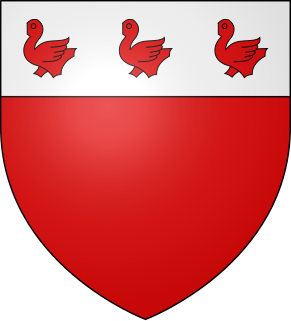
Belgium competed at the 1948 Summer Olympics in London, England. 152 competitors, 132 men and 20 women, took part in 77 events in 17 sports.

St. James' Church is a former Collegiate church in Antwerp, Belgium. The church is built on the site of a hostel for pilgrims to Santiago de Compostela. The present building is the work of the Waghemakere family and Rombout Keldermans, in Brabantine Gothic style. The church contains the grave of Rubens in the eastern chapel.

Belgium competed at the 1936 Summer Olympics in Berlin, Germany. 150 competitors, 145 men and 5 women, participated in 72 events in 15 sports.
Charles Philippe Henri Jean Baptiste van de Werve (1706–1776), 1st count of Vorselaar, formed part of a very old, important and noble family of Antwerp.
Baron Charles-Henri van de Werve (1627–1696), Lord of Schilde, Lord of Giessen-Oudkerk, Lord of Wavre-Notre-Dame and Lord of Wavrans, formed part of a very old, important and noble family of Antwerp.
Charles Bernard Jean Ghislain van de Werve (1740–1813), 2nd Count of Vorsselaer, Baron of Lichtaert and of Rielen, Lord of Giessen-Oudkerk, formed part of a very old, important and noble family of Antwerp. He was the first of the van de Werve de Vorsselaer branch of the House of van de Werve.

Auguste II Marie Henri van de Werve (1764–1793), baron of Lichtaert, formed part of a very old, important and noble family of Antwerp.
Philippe Louis Joseph Ignace van de Werve, 1st Baron of Schilde formed part of a very old, important and noble family of Antwerp.

Jacques Joseph Marie François de Paul van de Werve, Baron of Schilde (1793–1845) was a member of a noble family of Antwerp.

Henri Marie Jacques Hyacinthe, Baron van de Werve et de Schilde was a Belgian nobleman.
Charles-Augustin van de Werve, count of Vorselaar, baron of Lichtaert and of Rielen
Charles-Augustin is a given name. Notable people with the name include:
Henri Van Lerberghe was a Belgian professional road bicycle racer. In 1919, he won the third edition of the Tour of Flanders.

Van de Werve is the name of one of the oldest noble families from Antwerp that is still in existence.

d' Ursel is the name of an important old Belgian noble family of German origin. The chief of the House is styled the Duke of Ursel, others are Count d'Ursel.
André van de Werve de Vorsselaer was a Belgian fencer. He won a bronze medal in the team foil event at the 1948 Summer Olympics.

The Centenary of National Independence Commemorative Medal 1830-1930 was a Belgian commemorative medal established by royal decree on 20 July 1930 to commemorate the 100th anniversary of Belgian independence.
John IV van de Werve, 7th Lord of Hovorst was a Flemish noble and knight.





